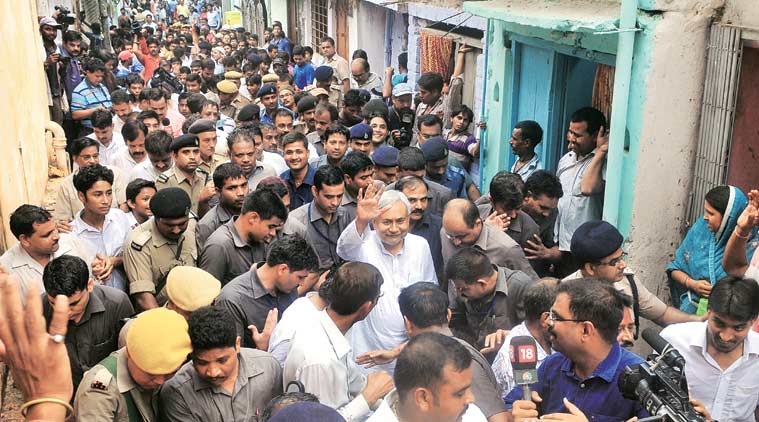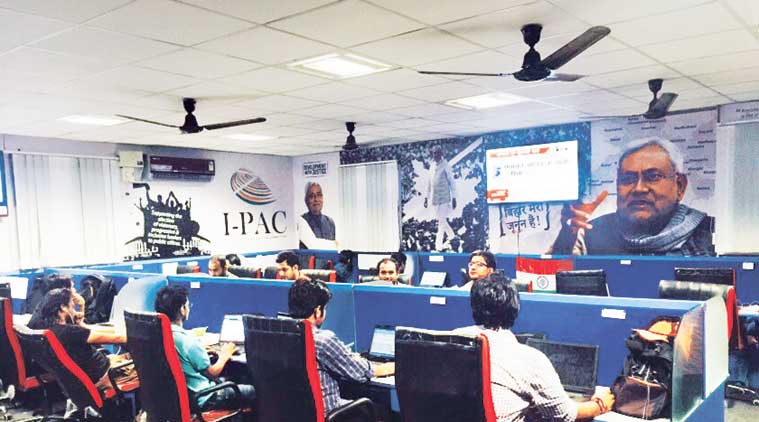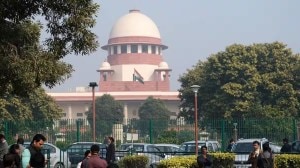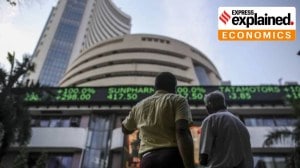- India
- International
Sunday Story: The Leader and his machine
A room in 7 Strand Road, Patna, is the nerve centre of Bihar Chief Minister Nitish Kumar’s election campaign. This is where a core team is working on a strategy that is focused on Brand Nitish, without the distractions of party and ideology.
 The group in the office on Strand Road is part of a larger 300-plus team of the Indian Political Action Committee (IPAC) that is mostly, about 70 per cent, made up of IIT graduates who have left high-paying jobs in MNCs to join the Nitish campaign. (Source: Express photo by Prashant Ravi)
The group in the office on Strand Road is part of a larger 300-plus team of the Indian Political Action Committee (IPAC) that is mostly, about 70 per cent, made up of IIT graduates who have left high-paying jobs in MNCs to join the Nitish campaign. (Source: Express photo by Prashant Ravi)
The dates of the Bihar polls scheduled for later this year are yet to be announced, but in a “war room” inside a bungalow on 7 Strand Road in Patna, Nitish Kumar’s campaign has been up and running since early March. Here, the walls are busy with Nitish posters, flashing TV screens and quotes of Plato and Michael Porter. And a core team of about 40-50 young men and women works daily into the night.
[related-post]
The group in the office on Strand Road is part of a larger 300-plus team of the Indian Political Action Committee (IPAC) that is mostly, about 70 per cent, made up of IIT graduates who have left high-paying jobs in MNCs to join the Nitish campaign. A need to be part of something larger and bigger, to connect and contribute to the “social” and the “political”, had earlier led some of them to the Citizens for Accountable Governance (CAG) that worked on Narendra Modi’s Lok Sabha campaign in 2013-2104 — the leftover CAG has now flowed into the IPAC. Others have come directly to the IPAC. Very few, only two in the core team, belong to Bihar. All are taking a break from their jobs, and though there is much talk about “risk-taking”, they seem to have little or no insecurity about finding another one. For now, till the election is done, they are offering their services to the “Leader”.
 Members of the Indian Political Action Committee inside the war room at 7 Strand Road in Patna. (Source: Express photo by Vandita Mishra)
Members of the Indian Political Action Committee inside the war room at 7 Strand Road in Patna. (Source: Express photo by Vandita Mishra)
“We wouldn’t have taken the plunge to back a party or any impersonal structure” says Rishi Raj Singh. “I would not have left my job for the BJP earlier. I did it for Modi. I am working for Nitish now, not for the JD(U)”, he says. Rishi, from IIT Kanpur, has worked in Mumbai in an infrastructure bank, and was with the CAG’s Modi campaign earlier. “Modi was the trigger”, agrees Vinesh Chandel, who is from the National Law School in Bhopal, has practised in the Supreme Court and was also earlier part of the CAG. “We needed a leader for change, and to show us the way. We felt we must do something.”
The transition for those who helped run the Modi campaign in 2013-2014 to the Nitish campaign in 2015 appears seamless. “When I first came to Bihar, I could see only one man who can be chief minister”, says Rishi. “Here, it can’t be Modi”, he says. “The geographies are very different. Modi’s theories won’t work in Bihar”, says Vinesh.
Paroma Bhatt, a masters in international law and economics, who worked at the WTO before she joined the Nitish campaign a month ago, says that she subscribes to “Nitish’s socialist policies”, because “it has to be about distribution” in Bihar. But for the most part, agreement with the Leader’s ideology doesn’t seem to be a necessary part of working with him. Even for Paroma, “This (working in the Nitish campaign) is an investment in myself”, above all.

The line that connects each member of this group to the Leader is mostly straight and mostly untrammelled by the distractions and diversions of party, geography, ideology. What they all seem to share in common, however, apart from a passion for Nitish now and Modi earlier, and a zest for self-improvement, is “quant ability”, or an aptitude for statistics, logistics and data.
The posters that dominate the Patna skyline with the common tagline, “Phir ek baar, Nitish Kumar”, the Facebook page and the door-to-door “Har Ghar Dastak” launched earlier this week, are visible. But since it set up base in Patna, the IPAC team has also been working in quieter ways.
To get a ground-level sense of the caste equations and demographics, smaller groups have fanned out to each of the state’s 38 districts to conduct “FDGs” or focused group discussions at chai shops, aanganwadis and in the homes of ordinary folk and local notables. Individually and in groups, team members have also conducted “IDIs” or in depth interviews with those deemed to be opinion influencers in the state.
The reports of all the sub-teams have been compiled and any member can access ready-made summaries of constituency-wise data and poll issues, along with details of the 60,000-odd polling booths in the state. This data also feeds into the presentations that IPAC team members make to members of the JD(U).
“In this office, even if we have to put up a coffee vending machine, the decision is taken only after presentations are made on the pros and cons”, says Rishi, only half-jokingly.
And many tell stories of how their parents still cannot comprehend why they left their jobs. “My parents don’t understand. What is it that you are actually doing, they ask”, smiles Vinesh.
*** *** ***
The story goes that Prashant Kishor’s father didn’t speak to him for six months after Prashant told him he was leaving his well-paying job at the United Nations to explore his skills as an election strategist and planner for a leader who “delivers” — an ideology-agnostic formulation his teams seem to have imbibed from him. Prashant was the lead choreographer and mastermind of the CAG and he now runs the IPAC. He worked as a public health professional for 10 years, including one and a half years in Bihar. He had done a stint in Africa just before he resigned his job on December 11, 2011.
Prashant, whose father retired as a doctor in Bihar, also contributed to Modi’s Gujarat 2012 assembly campaign. But it was his choreography for Modi’s spectacular Lok Sabha campaign that has ensured that the spotlight chases this backroom strategist ever since. While working with Modi, he set up base in the Gujarat CM’s residence. Since June 2, he has shifted into Nitish’s residence in Patna to run his campaign.
According to sources, Prashant’s campaign strategy for Nitish, like his strategy earlier for Modi, will frame, and pare down, the choice for the voter to one question: are you with Nitish or against him?
When Prashant came to Nitish in December 2014, he found that, from his point of view, the conversation in Bihar, and its electoral dilemma, was cluttered with too many moving parts. The conversation was mainly about how to keep the Modi-led BJP from taking over the state. The flamboyant Lalu was being projected as the “bada bhai” or elder brother in the JD(U)-RJD alliance that had been struck ahead of last year’s by-polls. And, Jitan Ram Manjhi, Nitish’s nominee, whom he installed as chief minister when he resigned after his party’s Lok Sabha rout, was increasingly striking out on his own.
Things have changed since then, and the focus has shifted inexorably to Nitish. First, Manjhi was removed as CM and Nitish came back as chief minister. Then, Lalu’s “optical visibility” has been on the decline. The strategist, sources say, will aim to underline and build on this shift.
It is not just that Lalu, who hogs every show and dominates every stage he appears on, is absent from the Nitish posters across Patna. Lalu has also been persuaded or pressured into accepting Nitish as the alliance’s chief ministerial candidate and climbing down in terms of his demand for seats — from 140 to 100 (in a total of 243). For Prashant, however, even an equal 100-100 division for the RJD-JD(U) would be conceding far too much to the RJD and could cause confusion in the campaign he is building around the persona of Nitish. He would like the RJD to come down further, it is said, to 80, and preferably to 60 seats, while the JD(U) keeps 100.
Prashant’s campaign for Modi purveyed intimacy with the Leader through the “chai pe charcha”, but he is better known for the the hi-tech projection of Modi in 3D. The core idea in constructing and reinforcing Brand Modi was the packaging of a Leader who can do the unimaginable, appear out of thin air at multiple places at the same time, brandishing all the answers. The Nitish campaign, on the other hand, sources say, will push technology firmly to the back seat. The branding of Nitish will require him to knock on doors, as he did on the launch of the “Har Ghar Dastak” this week, and to approach the voter with humility.
Despite the differences, however, the Prashant Kishor strategy, in the country for Modi, and for Nitish in Bihar, is to set up the teams and systems that will organise and streamline the resources and energies needed to package and promote the Leader. Even though electoral contests in India have always been presidential, this single-minded focus and this organised machine is new and remarkable.
*** *** ***
The arduous and ardent building of Brand Nitish for this election speaks about a dilemma Nitish shares with many other politicians in the country today, and also about his specific predicament.
Like other leaders in the country, Nitish today is less confident, more risk averse. These are times when political leaders must cope with a quick-changing, increasingly volatile electorate, one that is also younger and more impatient. At the same time, party structures are losing their vitality and do not serve as dependable sources of information for making political judgements anymore. In this situation, the choice for Nitish is to rely on his gut and his instinct even as the political environment grows more unpredictable and complex.
Nitish, moreover, has seemed especially unsettled and disoriented ever since he broke the JD(U)-BJP alliance after Modi’s coronation as the BJP’s prime ministerial candidate in June 2013, and then suffered a setback in the Lok Sabha election in 2014.
This is where a machine, of the kind Prashant Kishor offers, can prove to be seductive and useful — at the very least, it offers information from a standpoint that is relatively disinterested.
It could also be said that in Bihar the space for a campaign obsessively focused on the leader, as opposed to ideas and ideology, has existed for some time now, waiting to be filled.
Bihar politics, arguably, is at a point of ideological exhaustion and has been for some time now. In recent history, the high water mark in the state in terms of political mobilisation was the JP movement of the ’70s. This was followed by the Mandal moment and its turbulent aftermath in the ’90s, when the politics of dignity reset the terms of the political-electoral contest and debate.
The JD(U)-BJP alliance that followed, however, may have announced the beginning of a post-ideological phase in Bihar politics — it made little or no ideological sense, even as it seemed to open up some space for governance by forging an unlikely coalition of extremes.
Bihar, in this reading, could be said to be ready for a campaign that focuses on the branding of the Leader, even if he is projected to be humble, to the exclusion of all else.
This may well be true, but there will be problems for the leader-centric campaign in Bihar. For one, Nitish is a more grounded, less inflatable figure than Modi. Then, though Nitish can control and even disregard his party like Modi, unlike him he cannot do that to the other parties in his alliance.
No matter how much Lalu is persuaded to lead from the back this time, Nitish must still perform a difficult and delicate rope trick. He must hold out reassurance to Lalu and to the RJD, which is more of a party and therefore less easily relegated than his own JD(U). Nitish’s leadership, therefore, must also be about consensus-building.
Nitish’s challenge will be to keep Lalu engaged while keeping at bay, or countering, or compensating for the polarisations Lalu brings with him — the joining together of their respective Muslim vote banks could well provoke a consolidation of the “Hindu” vote. Then, apart from turning away the upper castes, the Yadavs also rub many of the Other Backward Castes the wrong way.
Finally, the problem also is that while Modi had to be taken to the people, into states and spaces outside his own realm of Gujarat, there is no such distance left to cover in Bihar. The state’s politically engaged people, who frame every expectation, every complaint as a demand to the state, possess and own their leaders already.
*** *** ***
This election in Bihar promises to be a critical one. At a time when it seems that the Modi government is losing its winning touch, it could breathe new life into the BJP or leave a scar it could find difficult to smooth out. For the opposition, it could portend a revival or further fragmentation. The political stakes are high.
It will also be the testing ground for a new way to fight an election, and its new machine.
Apr 16: Latest News
- 01
- 02
- 03
- 04
- 05






































